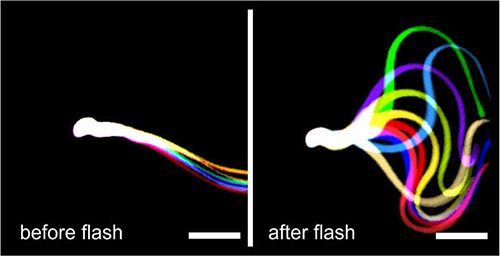By using pulses of light to control sperm function, scientists have not only induced vigorous beating in formerly listless flagella, they have also restored fertility to once sterile mice. The scientists achieved all this through an application of optogenetics, which involves the insertion of genes that code for light-sensitive proteins.
To date, optogenetics has been most prominent in the neurosciences, where light-sensitive ion channels are used to control the electrical activity of nerve cells. But optogenetics is becoming more versatile. As the current study demonstrates, optogenetics can be used to switch messenger-mediated signaling pathways in cells on and off.
Scientists from the Center of Advanced European Studies and Research (caesar) inserted a gene expressing a photoactivated adenylyl cyclase into mice that lacked the endogenous enzyme. Sperm of these mice are usually non-motile, and the mice consequently infertile. After simulation of these sperm with blue light, they produce cyclic AMP (cAMP), start to swim again, and are even able to fertilize eggs.
These results were reported January 20 in the journal eLife, in an article entitled “Controlling fertilization and cAMP signaling in sperm by optogenetics.”
The light-activated adenylyl cyclase had been discovered earlier in soil bacteria—hence the enzyme’s acronym bPAC, for bacterial photoactivated adenylate cyclase. In transgenic sperm, bPAC mimics the action of the endogenous soluble adenylyl cyclase (SACY) that is required for motility and fertilization.
“Light-stimulation rapidly elevates cAMP, accelerates the flagellar beat, and thereby changes swimming behavior of sperm,” wrote the authors of the eLife article. “Furthermore, bPAC replaces endogenous adenylyl cyclase activity. In mutant sperm lacking the bicarbonate-stimulated SACY activity, bPAC restored motility after light-stimulation and, thereby, enabled sperm to fertilize oocytes in vitro.”
The enzymes known as adenylate cyclases synthesize cAMP, an important cellular messenger. cAMP controls a wide range of functions such as heart rate, the sense of smell, learning, memory formation, and the fertilization of eggs. By optogenetically influencing adenylate cyclase levels, and thereby cAMP levels, the caesar scientists have shown that it is possible to control the behaviors of single cells, and to restore a fundamental biological process such as fertilization.
Anticipating future work, the scientists noted that the optogenetic toolkit has been recently expanded by a light-activated phosphodiesterase (LAPD) that hydrolyses cyclic nucleotides upon stimulation by red light. “A combination of LAPD and bPAC with fluorescent cAMP biosensors holds great promise to map the dynamics of cAMP signaling in live cells in precise spatio-temporal and quantitative terms,” they explained. “These findings encourage future studies to explore the full potential of controlling cellular messengers by optogenetics.”







